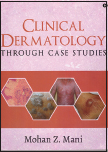Translate this page into:
Clinical dermatology through case studies
Correspondence Address:
Sujay Khandpur
Department of Dermatology and Venereology, All India Institute of Medical Sciences, New Delhi - 110 029
India
| How to cite this article: Khandpur S. Clinical dermatology through case studies. Indian J Dermatol Venereol Leprol 2020;86:104 |

Author: Dr. Mohan Z. Mani
Edition: 1st
ISBN: 978-1-64587-106-4
Pages: 205
Publishers: Notion press
Price: Rs. 1550/-
I always like a book opening with dedication to one's parents and teachers who are the most important contributors in shaping an individual, and Dr. Mani has begun his book by remembering them.
This book is written in a case report format, in which the author has discussed 25 skin conditions by describing their brief history, dermatological examination, provisional diagnoses, investigations and treatment along with response. He has supplemented this with clinical images taken in different stages of the disease and photomicrographs. This has been followed by a brief theoretical description of the disease and management strategies. The format is a pragmatic way of learning about these diseases, the difficulties encountered while managing them and ways to overcome them. The 25 cases include the frequently encountered ones in dermatology practice such as psoriasis and pustular psoriasis, genital ulcer diseases and urethral discharge, a few deep fungal infections and vesiculobullous disorders, dermatological emergencies like Stevens–Johnson syndrome/toxic epidermal necrolysis, drug exanthema, etc., and common genodermatoses. It gives a fair idea on how to approach a skin disease. It makes for effortless reading for a dermatologist as he will be able to relate to all the situations mentioned in the book. At the end of the book, there is a glossary of definitions of primary and secondary skin lesions and dermatopathological terms, followed by an index.
The strength of the book lies in its simplicity. But there are a few lacunae, which if overcome in subsequent editions, would make for a better read. The quality of clinical and histopathological images can certainly be improved in terms of area of view, clarity, focus, better lighting, orientation and other details. Some treatment modalities mentioned are old and therefore newer management strategies can be incorporated in subsequent editions. Supplementing these cases with close clinical and histopathological mimickers would also add value.
Overall, this compendium gives a comprehensive view of some common dermatological conditions in an easy to read format. It will help the undergraduates during their clinical teaching, and also postgraduates, especially the first-year residents, in understanding the approach to these conditions. Professor Mani certainly needs to be complimented for his effort in compiling these 25 cases.
Fulltext Views
4,052
PDF downloads
2,076





